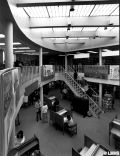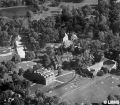



| <-- Previous | LMHS Home | Contents | Order Book | Next --> |

The Episcopal Academy’s 1887 location on Fourth Street, between Market and Chestnut, in Philadelphia.
The Episcopal Academy was founded in 1785 by the Right Reverend William White, the first Episcopal Bishop of Pennsylvania. Among its charter trustees were leading citizens of Philadelphia and signers of the Declaration of Independence and the U.S. Constitution. The school stressed both a classical education (Latin and Greek) and more practical study (business mathematics). The original campuses were in the city of Philadelphia and, after World War I, their quarters seemed more suitable for a hotel or an office building. Should they merge with another school? Should they move? The decision was made in 1921 to purchase John O. Gilmore’s 19-acre estate Yorklynne along City Avenue, then an unpaved country lane. The academy has, over the years, expanded to 32 acres and features a number of classroom buildings; athletic fields; a library-learning center; theatre, music and art facilities; a high-tech computer facility, and two gymnasiums. Episcopal offers college preparatory education for more than 1,000 girls and boys from junior kindergarten through the twelfth grade.

Dietrich House, 1904 Tudor style mansion along Latches Lane, was the former residence of Dr. Albert Barnes. The Dietrich Foundation aided Episcopal in the purchase of the estate. After extensive remodelling, the building has housed lower school classrooms since 1961.

Christ Chapel was designed by noted architect Vincent Kling. Opened in 1962, Academy students attend service three times a week and a special lower school service is held once a week.

The Roger Annenberg Memorial Library Learning Center, designed by Mirick, Pearson, Batchelor in 1972, is the central core of Episcopal’s Main Building which houses its middle and upper schools.

Upper school students are "Big Brothers" and "Big Sisters" to lower schoolers, a project of the nationally recognized Community Service program.
Friends’ Central School was founded in 1845 by a joint committee of three Philadelphia Hicksite Meetings. All children of Quaker families were welcome to attend as were children of non-Friends families. On opening day in September 1845, there were 98 boys and 102 girls in the five classes ...a 15 dollar tuition for each term. There were many difficulties in the first few years. However the desire of the education committee to have a school and maintain its program of education never wavered despite the competition of free public education in Philadelphia and earlier Quaker schools. During the next 68 years, the school’s enrollment dramatically increased. Despite several relocations of the schoolhouse, the need for more classroom space increased and there began a search to expand their city school facilities. The spot was found on City Line Avenue, near 66th Street, the Wistar Morris Estate. Here were 15-1/2 acres surrounding the mansion house.
The Morris residence, modeled after a Scottish castle, became the main school building. The surrounding cottages were used as a science laboratory and residence for the headmaster; the barn for art classes, locker rooms and maintenance. The site also had spacious land for playing fields. A gymnasium was soon built.
Here the school has remained since 1925, surrounded by the beautiful campus which is part of the land grant to William Penn by King Charles II of England. New buildings have been added: science labs replaced the old gardener’s cottage behind the residence; two buildings were added nearby to increase classroom space. The Linton gymnasium enlarged the playing courts for the Rex gym. A swimming pool was an important addition for the summer day camp and neighbors.
In 1986 the barn was gutted and transformed within the original stone walls into the Blackburn Library.
With the school’s purchase of the Montgomery Country Day School in nearby Wynnewood, it was able to greatly expand the Lower School facilities.
Over the years, the educational process and programs have developed a unique process for preparing the students for life. The school’s strong mission and commitment to the principles of the Society of Friends have continued since 1845.
In 1882, several prominent Main Line families, including as the prime mover, Mrs. Alexander J. Cassatt (wife of the president of the Pennsylvania Railroad) felt the need to establish a fine boys school in the area. The following year, Mrs. Cassatt and her followers offered to build a schoolhouse on the grounds of Haverford College. It was then agreed upon that the school would be directed by the college managers and used as a feeder school to the college. The new boys preparatory boarding school was opened on September 13, 1884 as The Haverford College Grammar School. Mr. Dean Sharpless was appointed as the Manager and later that year Charles Summer Crossman was named the Headmaster. By 1903, the school withdrew from the college and became an independent nonprofit school still known as The Haverford School.

Aerial view, c. 1930. Haverford College at upper left with Haverford School in the foreground, including Wilson Hall, the new Junior School and the Gym (at right).

1906 school play. Bill B., a one act entertainment, and an opera, Laya Krachina. Performances were at the Merion Cricket Club in March.
| <-- Previous | LMHS Home | Contents | Order Book | Next --> |